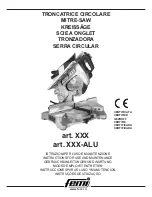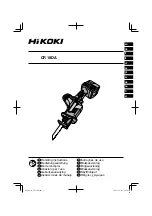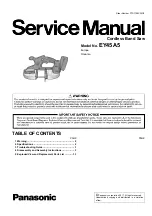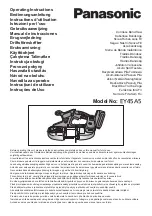
16
Slightly loosen handle (E) on floating jaw to allow it
to conform to tapered or irregularly-shaped pieces.
Then tighten handle before operating.
TIP:
Always verify 90-degree vise position by using
a square against blade and vise.
The vise handles are adjustable. Pull up on handle
and rotate it on pin, then allow it to drop back onto
pin.
Make sure vise handles are positioned to
prevent contact with descending bow.
Figure 8-16: vise positioning (712DV only)
8.16
Vise positioning (712V only)
To set vise for 90-to-45 degree cutting:
1. Remove bolts (F
1
/F
2
, Figure 8-17) from fixed
jaw.
2. Position fixed jaw over innermost set of holes,
as shown. Install bolts and tighten bolt (F
1
),
enough that jaw is still allowed to pivot. Set jaw
to desired angle according to scale at rear of
bed and tighten bolt (F
2
).
3. Adjust floating jaw parallel to fixed jaw by
loosening bolt (G, Figure 8-17), adjusting to
parallel, and retightening bolt. Use handwheel
(A) to move floating jaw to open and close vise.
Figure 8-17: vise positioning (712V only)
To set vise for maximum width of stock cutting,
position fixed jaw in outermost set of holes (H,
Figure 8-17).
Always verify that vise jaws and blade guides
will not obstruct one another as bow descends.
9.0
Operation
9.1
Blade break-in
New blades are very sharp and, therefore, have a
tooth geometry which is easily damaged if a careful
break-in procedure is not followed. Consult the
blade manufacturer’s literature for break-in of
specific blades on specific materials. However, the
following procedure will be adequate for break-in of
JET-supplied blades on lower alloy ferrous
materials.
4. Clamp a round section workpiece in the vise.
The workpiece should be 2 inches or larger in
diameter.
5. Set the saw on low speed. Start the cut with a
very light feed rate.
6. When the saw has completed 1/3 of the cut,
increase feed rate slightly and allow saw to
complete the cut.
7. Keep the same hydraulic cylinder setting and
begin a second cut on the same or similar
workpiece.
8.
When blade has completed about 1/3 of cut,
increase feed rate. Watch chip formation until
cutting is at its most efficient rate and allow saw
to complete the cut (see
sect. 9.3, Evaluating
cutting efficiency).
9. The blade is now ready for regular service.
9.2
General operating procedure
General rule for band saw blade speed: The harder
the material being cut, the slower the blade speed.
Refer to a machinist’s handbook for recommended
speeds.
IMPORTANT:
When cutting magnesium, never use
soluble oils or emulsions (oil-water mix) as water will
greatly intensify any accidental magnesium chip fire.
See your industrial coolant supplier for specific
coolant
recommendations
when
cutting
magnesium.
1. Give machine an overall inspection. Verify that
all guards, covers, etc. are in place and in
working order, the blade is tensioned properly
and tooth direction matches arrow on bow.
Check that blade guides and wire brush are set
correctly.
2. Raise bow until it will clear workpiece by a few
inches, and secure in position by closing
cylinder valve.
Always secure bow in
raised position before loading material.
Never start a cut with blade contacting
workpiece.
Содержание HVBS-712V
Страница 21: ...21 12 1 1 HVBS 712V 712DV Bed and Stand Assembly Exploded View ...
Страница 22: ...22 12 1 2 HVBS 712V 712DV Bow Assembly Exploded View ...
Страница 30: ...30 This page intentionally left blank ...
Страница 31: ...31 This page intentionally left blank ...
Страница 32: ...32 427 New Sanford Road LaVergne Tennessee 37086 Phone 800 274 6848 www jettools com ...
















































